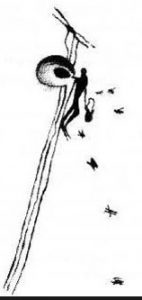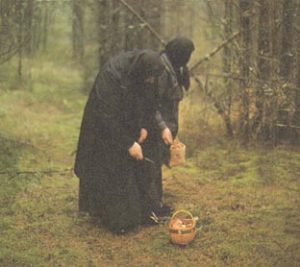
A person gathering honey (Arana Cave, Spain, 8000 BC)
What is gathering?
Gathering means collecting plants that grow wild for food. Early humans gathered all of their food from the land around them.
History of hunting
And of fishing
Early African food
History of food
What foods did people gather?
At first, when all people were still in Africa, they mostly gathered figs, just as chimpanzees do. Then they added dry grass seeds, and roots, and shellfish – mussels and clams.
More about figs
How to eat figs
History of honey
Gathering seasonal foods
Later on, when they moved to West Asia where the seasons changed more, men and women and children moved from one place to another: in February, they might be gathering wild greens like parsley, mint, or onions, and and chickpeas. In April, they climbed trees and cliffs to get bird eggs from their nests.
What are chickpeas?
History of eggs

Gathering food: Walnuts
In May, kids searched for wild strawberries, and in June they harvested wild barley and wheat and millet and lentils. They cut straw to make hats and sandals and sleeping mats and baskets.
History of straw
What are lentils?
Later in the summer people picked figs and apples, and in the fall it was chestnuts and mushrooms and almonds and walnuts from trees.
Where are apples from?
More about mushrooms
How about chestnuts?
Olives and olive oil
In November, it was time for the olive harvest. In each season, they ate some of what they gathered, and stored some for other seasons by drying it or smoking it or pickling it. People also got food from hunting and fishing, but most of what they ate came from gathering.

Gathering food: Wild strawberries
Gathering new foods in new places
As people spread out all over the world, they kept on gathering clams and mussels. But they also gathered whatever grew in each place. In India people gathered sugar cane and bananas and cotton.
What is sugar cane?
History of bananas
Where is rice from?
In China, they gathered rice and peaches, millet and tea. Over in North America, people gathered wild rice, pine nuts, and acorns. In South America, it was tomatoes, peanuts, avocados and chocolate. And in Europe, people gathered chestnuts and nettles.
Where are tomatoes from?
How about avocados?
History of chocolate
The addition of farming
Until around 8000 BC gathering was the main source of food. Around 10,000 BC, in the New Stone Age, people began farming, and therefore spent less time gathering. Now they grew figs and grain instead of gathering them. People soon also began to grow parsnips and peas and chickpeas and lentils. In the Americas, Native Americans began to grow corn and potatoes, peppers and peanuts.

Women gathering wild mushrooms in the forest
Do people still gather?
Yes, people kept on picking many wild foods. They picked berries, apples, pears, olives, and nuts. They gathered snails from bushes and mussels and clams from the beach. By the Bronze Age, around 3000 BC, people planted more kinds of food and gathered less. Still, they picked nuts, mushrooms, herbs, and berries in the wild.
In fact, the situation has not changed much from then until now. Even today, many people still gather berries and nuts, and some people still gather mushrooms and herbs, nettles, mussels and clams.
Is gathering lazy and stupid?
It might seem like gathering is a lazy, disorganized sort of way to get food, and doesn’t need much knowledge. But really it is very complex. You have to know where the plants are, like where are the nut trees growing and where are the berry bushes. You have to keep track of when each of them will come ripe, so you don’t accidentally miss all the berries by not visiting their bushes the right week. And you have to arrange things so that you are in the right place at the right time.
Preserving food
Then also, once you have picked the food you have to preserve it and store it: you have to thresh the grain, and dry the berries and fruit and herbs, and pickle the olives. Usually people who get most of their food from gathering have a regular route that they travel around every year, designed so that they are at the nut trees when the nuts get ripe, and at the olives when the olives get ripe.
Why did people start farming?
But even with all this, studies of gatherers suggest that most gatherers only really work at gathering food for a few hours a day, much less than farmers work. That is, people began farming not because it was easier, but (probably) because it could feed more people on smaller patches of land.
Learn by Doing – Go Berry Picking!
Bibliography and further reading about gathering:
The Cambridge Encyclopedia of Hunters and Gatherers, edited by Richard Lee and Richard Daly (1999).By specialists, but accessible to interested adult readers.
Woman the Gatherer, by Frances Dahlberg (1983). A collection of essays.
Neanderthals, Bandits and Farmers: How Agriculture Really Began, by Colin Tudge (1999). An attempt to explain why people gave up gathering and began farming. Short, and not too hard to read.
Last Hunters-First Farmers: New Perspectives on the Prehistoric Transition to Agriculture, by T. Douglas Price (1995). A more academic book on the same problem.




umm this didnt show me anything about why people gathered berries and seaweed and herbs please post me a email or something telling me why peole gathered those thing thank you
People gathered food so they would have something to eat. Before people started farming, gathering was the only way they could get anything to eat. There weren’t any stores yet. Today, people still gather to get food to eat, even if they could also get food at the store. (And you could think of grocery shopping as a kind of gathering, too!)